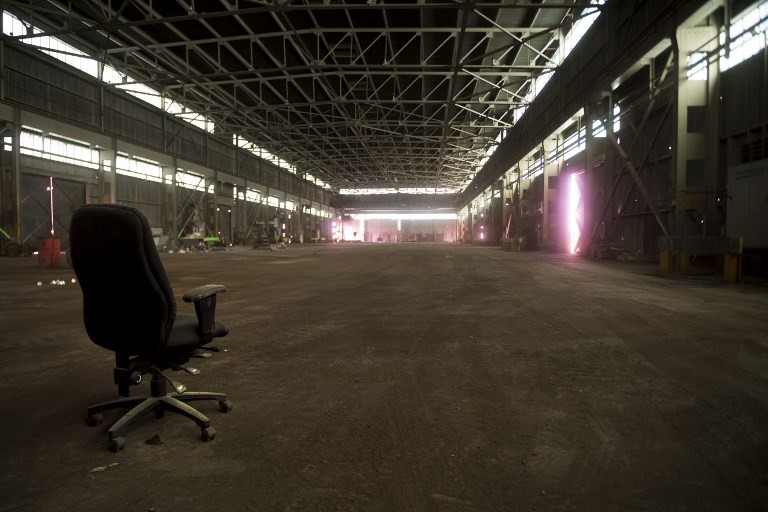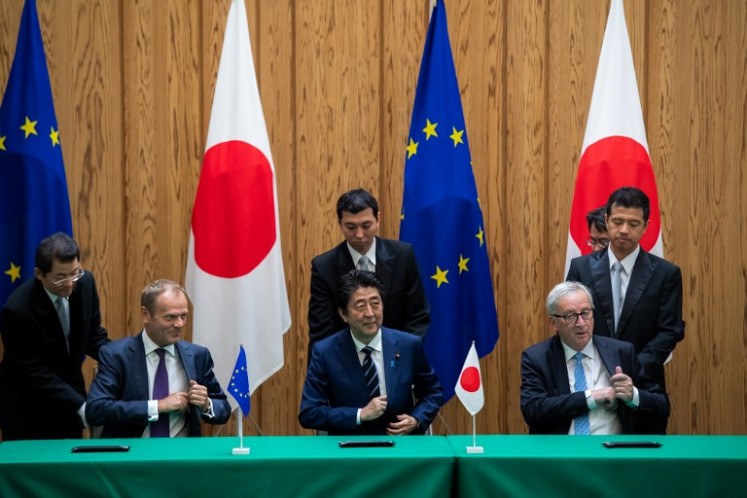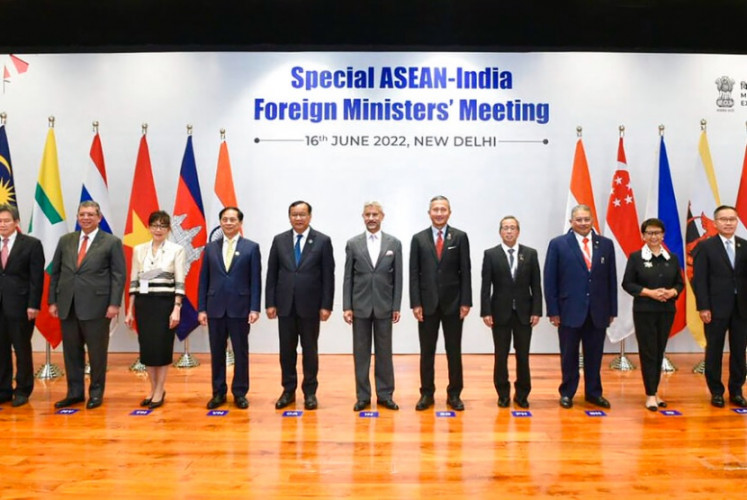A world without America
While the United States grapples with its internal demons, the world and Asia are moving on without the sole superpower.
Change Size
 A chair is left in the empty Bethlehem Steel warehouse building long ago abandoned in Baltimore, MD, on March 9, 2018. Sparrows Point was the largest steel mill in the world, famous for providing steel used to build the Golden Gate and George Washington bridges, but has been sold to Tradepoint Atlantic for a revitalization project that is bringing new industries to the area including Amazon and FEDEX. (AFP/Jim Watson)
A chair is left in the empty Bethlehem Steel warehouse building long ago abandoned in Baltimore, MD, on March 9, 2018. Sparrows Point was the largest steel mill in the world, famous for providing steel used to build the Golden Gate and George Washington bridges, but has been sold to Tradepoint Atlantic for a revitalization project that is bringing new industries to the area including Amazon and FEDEX. (AFP/Jim Watson)
O
n Tuesday, the European Union and Japan signed the Japan-EU economic partnership agreement in Tokyo following a summit meeting in the Japanese capital.
The entering into force of the agreement will bring into reality a massive free trade zone that accounts for about 30 per cent of the world’s gross domestic product, with a population of about 600 million, according to the Yomiuri Shimbun.
The pact — which both Japan and the EU aim to have come into force by early next year — will abolish or reduce tariffs on industrial products and agricultural items between the two sides and sets rules on investment, which is expected to help enhance opportunities for further two-way trade and investment.
The EPA “shows the unwavering political resolve of Japan and the EU to lead the world as a flag bearer of free trade amid growing protectionism,” Japanese Prime Minister Shinzo Abe said at a joint press conference Tuesday evening with European Council President Donald Tusk and European Commission President Jean-Claude Juncker.

The three leaders also issued a joint statement on Tuesday, reaffirming a shared policy of fighting protectionism in line with a similar expression in the communique adopted at the summit meeting of the Group of Seven major countries in Charlevoix, Canada, in June.
It was a direct rebuke to US President Donald Trump, who had refused to affirm the communique.
Trade, trade, trade
US Senate Finance Committee Chairman Orrin Hatch on Tuesday urged the Trump administration to change course on its global tariff policy that would hurt American businesses and consumers.
“The administration has implemented or threatened global tariffs on approximately $500 billion of goods,” Hatch said on the Senate floor.
But despite these calls by members of Congress, even those from his own party, to reverse course, Trump has pushed ahead with tariffs against friends and foe alike in order to ‘protect the American worker.’
These tariffs have sparked criticisms from all corners with the IMF on Monday saying that the tariff actions could lead to escalating and sustained trade conflicts that would derail the global economic recovery and dampen medium-term growth prospect.
“The risk that current trade tensions escalate further-with adverse effects on confidence, asset prices, and investment is the greatest near-term threat to global growth,” Maurice Obstfeld, chief economist at the International Monetary Fund (IMF) warned. “Countries must resist inward-looking thinking.”
These actions by the US government have made necessary allies out former foes and friends.
China has stepped into economic vacuums across Asia as the United States disengages from the region.
Beijing has released regular statements from its foreign ministry decrying protectionism – a stance that would seem highly hypocritical just two years prior.
On Monday, China’s permanent representative to the United Nations said that unilateralism and protectionism are a threat to global growth.
“China stands against unilateralism and trade investment protectionism,” Ma Zhaoxu said at UN headquarters in New York. “We believe trade disputes and frictions should be resolved in a reasonable manner.
“China will work with all parties to uphold free trade and multilateral trade system and maintain a common interest of all countries in the world,” he said.
Beijing has also made a strong effort to court European nations with promises of a large consumer market and infrastructure investment in Eastern Europe.
Belt and Road diplomacy
Beijing has used its Belt and Road Initiative to project soft power across the world, Asia notwithstanding. While this would normally be countered by US aid and diplomacy, Washington’s engagement with its various trade disputes and the US’s internal problems have seen China grow bolder in countries normally considered reliable US allies.
These erstwhile American partners have been lured by investment, uncertain security situations or a combination of both.
Thailand, the US’ oldest treaty ally in Asia, has pivoted hard towards Beijing to counterbalance US criticisms of a military coup under Barack Obama and indifferent foreign policy under Donald Trump.
The Philippines, a former US colony and geopolitical ally, has also been courted by Beijing despite longstanding disputes with China over the South China Sea.
Under President Rodrigo Duterte, the Philippines have accepted Chinese investment under its belt and road program and for months, the Philippines has been drumming up a joint venture with China to explore for oil and gas in a contested area of the South China Sea.
China has also bought into the Philippine telecoms industry. Shenzhen-based telco ZTE is leading a consortium that plans to invest US$2 billion (S$2.6 billion) to build 50,000 microcell towers and compete with the two leading players.
Most big-ticket infrastructure projects in the Philippines have some level of Chinese involvement, according to economic analysts working in the country.
Tourists from China are also pouring in. The Chinese have dislodged the Koreans as the top tourists on the resort island of Boracay. Some 376,000 tourists from the mainland visited Boracay last year, compared with 375,000 from South Korea.
According to the Philippines Daily Inquirer, China’s presence in the Philippines has never been more pronounced than it is now, President Rodrigo Duterte on Monday joked that China could make the Philippines its province.
Taming the subcontinent
China’s inroad into India is perhaps its most impressive feat, given the border disputes, mistrust and history between the two countries in the past fifty years.

Chinese President Xi Jinping and Indian Prime Minister Narendra Modi held talks in Qingdao, China, last month. It was the third face-to-face dialogue between the two leaders since September last year.
Through the Chinese-led Asian Infrastructure Investment Bank, over $1.4 billion has been spent on India – one of the highest shares among member countries.
A trade delegation led by Chinese Commerce Minister Zhong Shan purchased goods worthy of 2.4 billion USD in India.
China has also become India’s largest trading partner. Last year, the bilateral trade volume reached $84.4 billion. More than 800 Chinese companies are currently doing business in India. The two countries have set a new bilateral trade target of $100 billion by 2022.
Beijing has also waded into territory that it normally steers clear. In June, Chinese Ambassador Luo Zhaohui attempted to calm tensions between Pakistan and India by proposing a trilateral summit between the three countries.
“If China, Russia and Mongolia can have a trilateral summit, why can’t China, India and Pakistan?” he said.
As Indian newspaper the Statesman said in an editorial, “China’s antagonism with the United States has been escalating over bilateral trade. It is obvious that Beijing is aiming at mending its strained relations with neighbouring countries, including India and Japan, to solidify its diplomatic foothold.”








